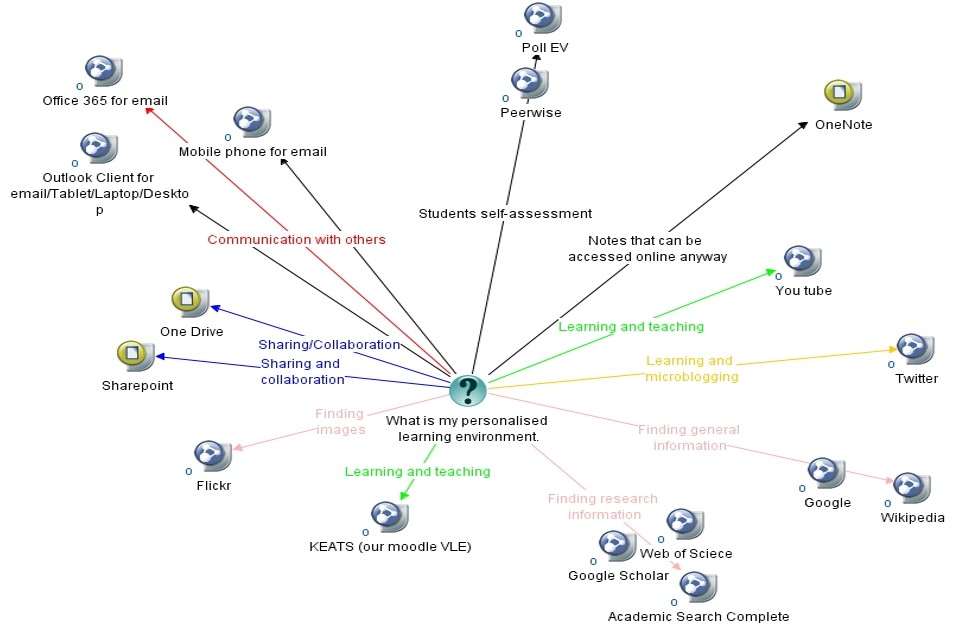A little bit of background
Recently on H800 we have been learning about the PLE. This in itself has been quite a eye-opener for me because I had never really thought of myself a having a PLE. I have worked with VLEs for years as a student and a teacher and I felt comfortable with the concept and tools found in VLEs. One of the early activities of the week was to map out a representation of our PLE and here is a copy of mine:
 Seeing this map made me realise that I use far more tools than those provided by the VLE. Even if I look only at those used for study of H800 a reasonable proportion would still be listed. So now that I have found my PLE, what do I really think it means.
Seeing this map made me realise that I use far more tools than those provided by the VLE. Even if I look only at those used for study of H800 a reasonable proportion would still be listed. So now that I have found my PLE, what do I really think it means.
The PLE and the VLE
As I said right at the start of this posting, I had long been familiar with the VLE but not the PLE. I have now had the chance to reflect on the positions outline by some researchers in the field and whilst I can see points in favour of focusing on a PLE, I still believe the VLE must remain the mainstay of formal learning. Weller convincingly points out that many tools out there are more sophisticated than the VLE and in some cases, students will perceive the VLE as antiquated and clunky. He also states how many are using these tools anyway. However, I think that to minimise any risk to the student and university, an institution must be able to provide appropriate support for all the technologies it employs and this is just not viable for the broad range that could be encompassed in the PLE. I also think that there is an issue of supporting the users who are least technically able - this group perhaps will not have such a broad understanding and use of technology when they enter education and therefore will benefit from a crude but well support VLE.
That said, I also think there is a perfectly reasonable middle ground here and it is dynamic platform. My own experiences of school leavers entering education is that they are quite limited in their technology skills - yes they can use google and facebook but not necessarily in any systematic and optimal way. In the transition year to higher education a VLE provided by institutions (in our case a platform based on moodle) can provide them with a concrete and all-encompassing resource. With seamless links from the university website to our moodle (which also links to specific places in the library) and office 365 they have access to most of what they need. As the student progresses we ensure they have more skills to select their own technology. For example, explaining the principles of databases and then giving a few examples before suggesting they explore and choose one for an assignment. Alternatively, we can set up RSS feeds into our VLE and teach them how to do the same, something they can then apply to their own choice of sites.
So in summary I see the VLE and PLE as things that can evolve together. You begin with a solid core VLE, safe, supported and restricted. From here the tools provided to the student by explicit teaching, and the experience they have the VLE, allows them to begin to rely more and more on their own chosen technologies, developing a robust PLE. I still seem some fuhndamental things the preserve of the VLE. Here are three key examples:
1. File Storage - the university must offer some way of storing files, this may be through something like OneDrive (ie outsourced but with responsibility) or it could be their own servers. This protects the students from loss of material, if they choose to use it. For many they will store assignment drafts elsewhere but this gives them a belt and braces approach and away for restoring lost work.
2. Assignment submission - this must be via the VLE. Whether the student chooses to submit a word file or image created in other software submission must be via the VLE. Assignments are stressful and issues with submission are sources of great worry even when the stakes are low for an individual piece of work so a university must be able to control and be accountable for this process to minimise damage to itself and its students.
3. Communication between staff and students - at my university we are only allowed to email students to their university account and not personal email addresses, the same is true in reverse. This is about protecting both staff and students and having an audit trail. It takes students a while to get used to this (it seems normal for staff) but it is beneficial in the end. It also helps people 'switch off' from work by not checking that particular email account.
This final point leads me to something I would like to finish with. Mental health problems are now a key concern for all universities with mental health problems rising in student populations. Many of my students admit to working/studying for ridiculous hours. I have also experienced this. With an all pervasive PLE there is a risk things will be harder to switch off from. Keeping the VLE at the centre (however wide the circle) can help with important boundaries.